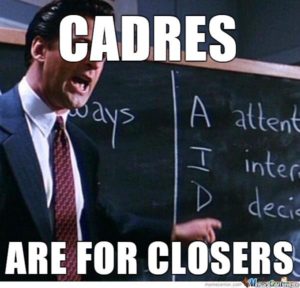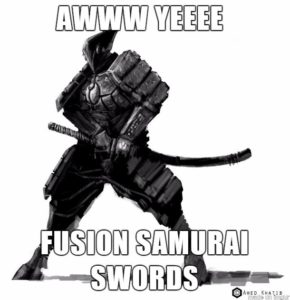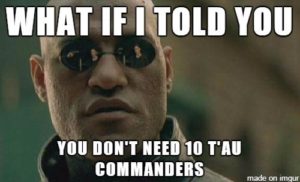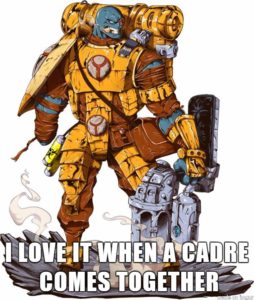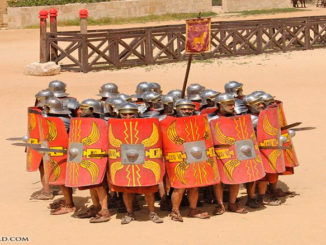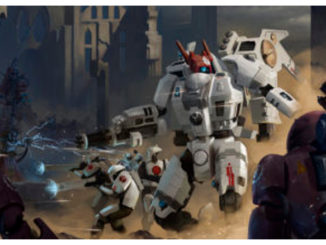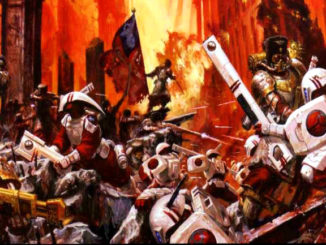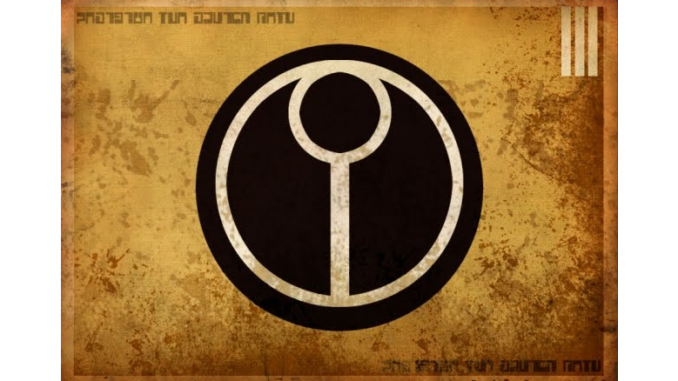
Greetings, Shan’al! In my previous article, I gave a general introduction into the T’au as they stood in 7th edition as opposed to their new foothold in 8th, and how dramatic that shift has been. I also spoke about how dead wrong I was about them being overly nerfed, and while I kept some tears flowing at the state of what we have to work with, I removed the salt. You can find those musings here!
In today’s article, I am tackling two huge topics that I believe should always go together: how to build a competent, balanced list, and how to plan playing with it.
Notice I didn’t say play? That’s because if you plan an idea without thinking about who you could be facing, you’ve potentially already lost. To only think about your list against some simulated enemy in your head is to plan in a vacuum chamber. Planning is key! And there’s nothing more fun than knowing your opponent’s rules inside and out. But, there are multiple factors to consider before we get to the part where we think about the bad guys.
The first factor for playing well in a competitive environment? The storyline.
1) Fluff and Style
Fluff, or the story behind the game, is a huge draw into the game itself for 99.99% of all Warhammer 40k players. The sheer variety of factions, storylines, and war stories behind the game inspire us players as to which models we decide to buy, and what factions we call our own (or primary, for those lucky enough to own multiple factions.)
However, while this is a great reason for someone to get into the game and pick a faction, how the faction is actually represented with rules may not always correspond to our mental picture of them. (Insert easily predicted salt-rage here of how a highly advanced T’au army with super guns and mech suits hits 90% of the time on a 4+)
Fluff might seem like a strange point to lead off with; hell I haven’t even mentioned list building yet! But to understand this is key to doing well. For example, in 7th, when I was just collecting models and building my army, I imagined T’au as this sit back and “shoot-away-at-everything-as-much-as-possible-behind-an-Aegis” type of army. While it served me decently well at first, the more competitive my chosen environment became, the more I needed to evolve to win, which meant adapting to playstyles I had not otherwise thought of for myself or for T’au.
This is completely true in 8th edition. As a friend of mine once pointed out, good players will always be good at their phase of choice, but great players have to know the assault phase inside and out. While assaulting armies still seem to be on a bit of a back foot currently (though nowhere near the vast divide it was in 7th), the assault phase, when done correctly, can really change the game.
We T’au players abhor the assault phase due to our civility and honor in war, but we have a chance to own (or hold our own) in that phase given that 80% of our roster has the FLY keyword. This doesn’t mean we’re gonna hit harder than a Genestealer pain train. Rather, we could easily build a strategy around deep striking flyer units that tie up enemy guns in assault after shooting a different enemy (Yes, even the “pseudo-fly” Ultramarines suffer from this, since after withdrawing they hit on 5’s, and cannot reroll 3’s and 4’s). Against a friend playing Space Marines, I found this to my advantage when I would drop Crisis teams in tandem with nearby stealth suits, have the both suit teams shoot up a unit to mulch or dust, then assault another unit that wouldn’t be able to fire after falling back, negating the enemy fire power and allowing my Crisis to try and pick them off later. (IMPORTANT: Space Marines can now intercept within 12” using a stratagem that costs 2 CP, but only once per movement phase. This can be planned against/avoided easily enough, but good to spread the word!)
My whole point being that you have to really think outside of your concepts of your army. Just because T’au aren’t good in assault doesn’t mean you shouldn’t, and just because you think a strategy is fundamental doesn’t mean it is.
As a last note, while we T’au players have the Mont’ka and the Kauyon fluffed into our heads by the Water Caste propaganda, it is actually dangerous to think strictly along these lines. The game, as simple as it has become, is now more vastly complex as well. While you can use these basic philosophies very generally, to attempt to strictly apply them (by building a rigid list following how we see them in the fluff) can be dangerous and lead to the opposite of the intended effect.
In summary: while play-style and faction can lead you to a certain way of thinking, be careful to not become cemented into them. It denies you the ability to adapt on the field, allowing you to overcome a natural habit or tactic in favor of something unique. A basic example is a Hammerhead gun-line with a Commander. Sure, going first, declaring Kauyon, and watching enemy models/vehicles disappear is a solid strategy. But if you’re afraid of going second, or if the enemy has lots of line of sight blocking terrain, giving up Kauyon and instead declaring Mont’ka to allow you to emerge from behind cover with no penalty can be just as deadly.
But in those cases, you still want the re-rolls of missed shots; who doesn’t? Well, that’s where list building comes in.
2) Everything In its Right Caste
T’au have a lot of cool units that can do cool stuff (please submit for best sentence ever, thank you.) Ghostkheels are nigh impossible to hit for some armies, Sniper Drones do sniper things, and Shadowsun makes a unit automatically re-roll ones, to name a few. So why is it that when we bring the units we like, they don’t perform as we expect? For myself, I have found this to be the case when I only look at their dataslate and not how they operate on a table.
For example, I was super pumped about the Ghostkheels being so cheap, and with stealth fields for days and melta guns in easy access to boot. However, running them I found that I couldn’t do squat (or even kill Squats if they were still in the game.) The range on their guns made their stealth fields slightly pointless since I had to get in close, and the removal of their stealth drones (easy to kill and a separate unit) made them able to be shot at as well. Then, to make them last, you need to bring a shield generator (40 pts…ouch), and target lock to ignore the Heavy weapon move penalty. Then, being so close to the enemy, markerlight support was never really viable, meaning that they’re hitting D3 melta shots plus 2 (using fusions and fusion collider) on 4’s, and wounding on 3’s against normal vehicle targets. The math on that does not check out, and let’s not even go into how worse they get when they degrade, with only 10 wounds total.
On the other hand, Kroot seem like garbage. A melee unit that has one attack per model at strength 4 (with the gun), no more sniper rounds, no supporting fire, with no bonuses in combat (unless you bring the almost pointless Kroot Shaper), and a 6+ save. My initial thought was “bleh, skip, pointless.” However, given the terrifying amount of pinpoint shooting deep strikers, fast moving melta planes, and the occasional assaulting army, they are insanely useful at 60 pts for 10. They provide T’au a cheap zoning potential, and earn their points back in dying to keep the gunline or critical units alive, or by temporarily holding an objective to score points. Kroot are a very effective screening unit at the moment, and with the T’au Codex coming out at some point (I heard a rumor that it’s coming in October….) they might have more useful rules.
The key thing here is that neither the Kroot nor the Ghostkheel are awful by themselves, but rather in a context. Ghostkheels could be amazing with close support Hazards, or Crisis suits with marker drones, or even Tetra skimmers. Further, Kroot could be awful in a suit heavy list where all they do is sit on objectives. But notice my second set of examples talk about other units as well? While other lists for other factions can have all-star units or all purpose units that don’t care about being in operation with other members of their lists or faction, T’au units have to function together. This is the main reason monster-mash or suit-spam lists are gone, and why most people tend towards Commander Spam; Riptide-variant suits and Crisis suits need support in order to be effective, whereas Commanders are one-man armies in a sense (Monat, anyone?), and only rely on easy access drones to give them the extra wounds and enemy shooting denial they need.
So, knowing that context is half the battle, let’s focus on the last piece for this article: planning for the enemy!
3) Railguns out, let’s do this!
Having meditated on the purposes of each unit with Commander Puretide, and how they interact together to create a forged purpose of advancing The Greater Good, you now are finalizing a list to beat the enemy on a table top. But before you get to the table, your list has to be ready to face what’s on it.
Every store/community has its own local meta. I’ve seen people post “unbeatable lists” in their group that would get utterly curb stomped in my local group, and vice versa as well. But that’s the key issue: you don’t know who or what you’re playing against. The greater frustration? T’au are soooooo good at building counter lists, but by default it becomes a scissor to someone else’s Exterminatus rock in a tournament.
While your list building decision should be your own, my personal belief is that balanced lists will win the day under the careful direction of a wise Shas’O. That’s part of the reason why Commander Spam works so well; they are able to handle a variety of lists very well, with the exception (as I believe) of hordes and artillery.
A balanced list is essentially that: balanced. It’s something that can deal with super heavies, hordes, elite armies, and artillery, and still make it home in time for dinner.
Immediately you should pull a Luke Skywalker and say “that’s impossible!” I’m going to pull a Kanye West and say “I’m gonna let you finish, but…”
Given the pricing of T’au models, and the hard decisions one has to make with those points and unit slots, it seems impossible to build a balanced list that says “I can take you on!” to every enemy unit it sees. But that’s the tricky part: a balanced list doesn’t mean you can kill everything you see. Rather, a balanced list says “I can kill that, but I couldn’t care less about that.”
For example, my current list is mostly tough units backed up by smaller troops in zoning roles and support roles, with several piranhas for extra seekers and mobility. While I know artillery will wipe out my smaller infantry units, that’s fine by me because they’re keeping fire off of my more heavy hitters, and I usually only plan on them being alive for one or maybe two turns. Then, depending on the artillery, I don’t care if it’s targeting my heavy units, or my heavies have shot them up by then. I have a life expectancy, timetable of necessary actions, and a damage potential for each unit. All three factors (and sometimes more) are how I judge whether a unit has earned its points back (think back to my Kroot example.)
No matter what faction you play, there’s going to be some counter to your build, or some pressure that throws your balance off. The key thing is to plan for that as best you can. Not just by bringing the guns that will kill those threats, but also by bringing the units that makes those threats moot, or maybe even by a strategy of bringing enough units that they enemy’s target prioritization is thrown off immensely.
Well that’s all for now. Tune in next week for my recap of how I perform (for better or worse *gulp*) in our local 2 Day GT! I’ll include summaries of each game, the opponents I faced, and what I found worked and what didn’t. I’ll also post my list and lots of pretty pictures for those of us that are illiterate!
After that, I’ll resume my series with playing the game itself, specifically about when your list is signed, sealed, delivered, and locking horns with an opponent.
For T’auva!

